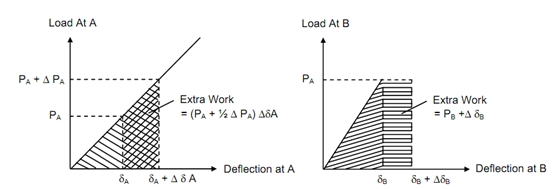Application of Castiglianos theorem:
Let us now consider the case where we apply the loads (PA + Δ PA), PB, PC, etc. gradually to the full value. As the ultimate loads in the case are exactly the similar as the earlier case and as all of the loads are applied statically, the ultimate deflections must also be the same. After that, the strain energy in the case, U′ (by neglecting product of small terms Δ PA Δ δA) would be as follows:


U ′ = (½) (PA + Δ PA ) (δA + Δ δA) + (½) PB(δB + Δ δB) + (½) PC (δC + Δ δC ) + ...
= (½) PA δ A + (½) PA Δ δA + (½) Δ PA δA + (½) PB δB + (½) P B Δ δB + (½) PC δ C+ (½) PC Δ δC + ...
= 1 P AδA + 1 PB δB + 1 PC δC + .. . + 1 PA Δ δA + 1 PB Δ δB + 1 P CΔδC + .. . + 1 Δ PA δA
= U + 1 PA ΔδA + 1 PBΔ δB + 1 P CΔδC + ... + 1 PA δA
Though, since loads in addition to deflections are the similar in both the cases, the total strain energy must also be the same. Hence,
U ′ = U + ΔU
or ΔU = 1 PA Δδ A+ 1 PB ΔδB + 1 PC ΔδC + .. . + 1 Δ PA δA
∴ 2ΔU = PA Δδ A + PB ΔδB + PC Δ δC + ... + Δ PA δ A
Earlier we have achieved
ΔU = PA Δ δ A + PB Δ δB + PC Δ δC + .. .
Now, from the last two expressions, we get
ΔU = Δ PA δA or ΔU / Δ PA = δA
In the limit, δA = ∂U / ∂PA
Likewise, it can be shown that ∂U /∂PB = δB , ∂U/ ∂PC = δC , etc.
Thus, in general, ∂U /∂PM = δM .
As a simple instance of the application of Castigliano's theorem, let us assume a bar of cross-sectional area A & length L under axial tension P. From previous section we have known that the strain energy U in this case is given as
U = P2 L /2 AE
If we differentiate U with P, we get,
∂U /∂P = PL/ AE
That we identify as the extension of the bar under the load P that is the displacement of the point of application of load P.